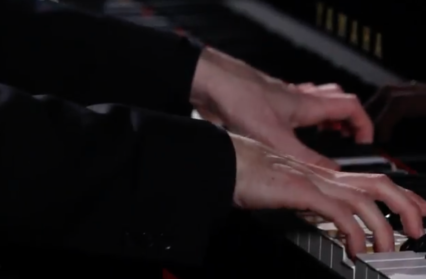Ten Acre Riots! is the latest instalment of David Roche residency, which is a composition by Roche for solo piano. Throughout 2017 these artists, including David Roche will take a leading creative role in what Wales Arts Review publishes, centring their skills on a challenging project over the course of a month. We were inundated with applications, receiving hundreds of emails about the positions, and it was no easy task whittling down all that talent to this final eleven. Our team of six editors debated long into the night, and in the end, we decided on a collection of people who we most want to work with, and whose work excites us. We think you will be excited by them too.
In this article, my second as Artist-in-Residence with Wales Arts Review, I wanted to take a look at my composition Ten Acre Riots! for solo piano. Before you work your way through what I’ve written I strongly recommend you listen to Ten Acre Riots! (see below) and have a peep at the score (here). This piece has some political components and they are discussed in good detail in the accompanying program note, so be sure to take a look at that too. I was particularly concerned with narratives relating to Brexit in South Wales and how these correspond to a series of riots that took place in my hometown, Tredegar.
The first serious, substantial piece I wrote for a solo instrument was probably a study for classical guitar. Sometime around 2008 I became dead set on attaining and developing some fiddly nylon-strung guitar techniques that were totally alien to me in my life as a shred obsessed electric guitarist. I thought the best way to do this would be to write a couple of pieces that focused on the technical elements I wanted to work on. Since then I have written 6 or so studies for classical guitar (you can hear one here, I’m performing it too:
I return to them every now and again for a good workout. They are idiomatic, tricky, and I enjoy the way they sound.
So, for a long time, I’d only ever really written solo works for the instrument that I played. This was a source of anxiety when I was selected for Psappha’s Composing for Piano scheme in 2016. As part of this project, I would be working with amazing pianist Benjamin Powell over 3 workshops, a rehearsal, and a recording session. The knowledge I felt I had as a guitarist far outweighed the knowledge I felt I had as a pianist but I wanted to do something unusual and I wanted to make this piece count. So I tried to think of some unusual compositional options and made sure I knew my onions.
With this in mind, the first thing I did was go and listen to as much modern piano repertoire as possible. There are tons of great pieces in which composers do wacky things with the instrument; John Cage wrote a lot of music for prepared piano; Ronald Stevenson used a lot of unusual techniques, (a good explanation can be found here); Helmut Lachenmann instructs performers to play different parts of the piano; Beat Furrer composes using lots and lots of clusters; Wyschnegradsky tuned his pianos microtonally, and Martyn Harry imposes some interesting restrictions using handcuffs (listen to Restraint). In terms of contemporary piano music more generally I was drawn to Unsuk Chin, her music is brilliant and is worth listening to over and over.
These pieces got the cogs in my head turning (very rare) and made me think back to an idea I wrote in my composition Depths, a solo piano piece composed as an exercise in 2009. In this piece the performer is instructed to finger a harmonic node (watch this video if you’re not sure what a piano harmonic is) on a string inside the piano before firmly pressing the string, bending it and causing the pitch to change.
I found that this sound worked especially well when combined with more percussive elements; very high harmonics on low piano strings, string dampening, and string dampening combined with the sustain pedal. By simultaneously sounding one-note and bending another I also found that I could make the beat frequencies (find out what they are here) of the sounds interact, creating a kind of strange vibrato. In Ten Acre Riots! I use these sounds at bars 92-96 and bars 125+. This is all very well… but there’s more to this piece than harmonics!
The initial musical material for Ten Acre Riots! was actually developed from a technical concept. I had been using a particular, gradually expanding interval cycle – an interval cycle is a collection of pitches generated by moving from one point over and over by the same distance or pattern – to create a large network of frequently changing octatonic scales. The octatonic scale has qualities of major and minor scales, these qualities act as reference points and they help guide our listening. The mixture of major and minor elements also creates a little instability. The interval cycle I used expands by a semitone with each note that is sounded. Eventually, I start 2 new cycles of this type moving in opposite directions from a note generated by the cycle. These new lines bifurcate, the new lines they create bifurcate, and this continues over and over.
Although I’m making this sound quite formal I actually treated the material in an extremely liberal way. My control over the gradual bifurcation, expansion, and contraction of these cycles allowed me to alter the dissonance and harmonic intensity of the piece as I saw fit. The example below, typesetting of the original sketch material of the piece, outlines how this actually worked in practice. I wasn’t strict or consistent at all – the upper part gradually gets bigger but I am being freer with the lower line. I just liked the way it sounded, it’s easy to compose intuitively using this method.
It might also be of interest to note that sometime after the second draft of Ten Acre Riots! I dramatically altered the structure of the work. I started repeating the motivic material from the initial bar, distributing it throughout the piece in an attempt to make the work tighter (which I feel it did). By this time I had totally stopped thinking about any strict processes. I was just following my intuition, emulating and developing material I had already written.
Another technical element worth chatting about in this piece relates to the use of multiple simultaneous tempi – different pulses happening at the same time. If you look at bars 72-82 you can see one voice in triplets, one in quintuplets, and one in standard crotchets and quavers. These voices are all moving at their own tempo even if they are all notated according to a single pulse. Conlon Nancarrow wrote some really interesting music in which different parts are heard performing in different tempi at the same time. Everyone should definitely check out Adam Neely’s accessible, fun discussion of this:
These kind of relationships are a big part of Ten Acre Riots!. When I first started writing this piece I created a rhythmic scheme that outlined a series of tempo modulations. Each modulation was anticipated by one of the pulse streams already being articulated. I came to this idea by combining two techniques popularized by American composer Elliott Carter (read the following article for some information about these techniques, the introduction and first chapter will help). I put my scheme into practice and liked about half of what came out of it… so I started hacking away at the material and tinkered around with the section until I felt it worked. In bars 83-91 you can actually see where I chopped up bars to alter the flow, I enjoyed the silences that occurred when I cut them up so I focused on them with a fermata or 2. I often find that composing using a strict process can get the musical ideas flowing – a jumping-off point. As an aside, make sure you check out Elliott Carter’s music:
A final point I’d like to make relates to bars 49-71. These rhythms were derived from a kind of change ringing processes – everyone should definitely check out how fascinatingly complex this type of music-making can be! 8 or so rhythms are repeated over and over in a manner that causes them to reiterate similar rhythmic cells but also drifts apart from each other. Before they moved too far from each other I abandoned the process I had set up and improvised it out using the materials that had been generated.
Since Ten Acre Riots! I’ve written quite a bit of music for solo piano. My pieces Endellion Miniatures. and The Most Wonderful Great and Mysterious Birthday Party Variations are two of my favourites. I also recently wrote a piece for 6 pianos that were performed by the immense Grand Band at the Vale of Glamorgan Festival earlier this year. Ten Acre Riots! went on to receive an Honorable Mention in the 2017 An Art Artistry Contemporary Piano Composition Competition and was awarded 3rd place in the first round of the 2017 International Antonín Dvořák Composition Competition. My orchestral piece Young Countries and solo piano piece The Most Wonderful Great and Mysterious Birthday Party Variations came third in the final round.
I hope you’ve enjoyed this article – I wanted to give a taste of technical and non-technical staff. Get in touch if you’d like to perform any of the pieces I’ve discussed (do it!). More next week!
This piece, Ten Acre Riots! by clare e. potter discusses his solo piano composition and is part of the Artists in Residence series.












